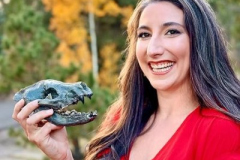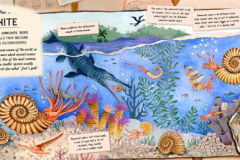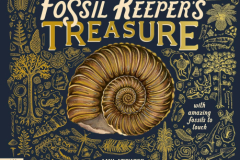Written by palaeontologist Amy Atwater and beautifully illustrated by Nat Cardozo, this brand-new book from publisher, Magic Cat takes young explorers on an exciting journey through time. From the earliest trace fossils, dating back 4.6 billion years, to the remains of our early human ancestors, Amy and Nat bring history to life in a fun and engaging way.
Each double-page spread showcases a different fossil discovery, bringing prehistoric landscapes to life through stunning illustrations. The scrapbook-style pages include fascinating facts, scientific concepts, and even embossed fossil impressions that readers can feel! If you love fossil hunting, you’ll love this extra sensory experience.
We were lucky enough to chat with Amy Atwater herself to find out more about her work as a palaeontologist and the inspiration behind The Fossil Keeper’s Treasure.
Meet Amy Atwater – The Fossil Keeper!
Rockwatch: Hi Amy! Thanks for speaking with us. Can you tell us a little about yourself and your work?
Amy Atwater: Sure! I am a palaeontologist, author, and science communicator. I recently wrote a children’s book called The Fossil Keeper’s Treasure, which features ten amazing fossils that changed our understanding of the world, and they are touchable! I am also the Director of Palaeontology at Dinosaur Ridge outside of Denver, Colorado, where we have hundreds of dinosaur tracks and bones preserved in the rocks. I also run a popular palaeontology Instagram account @mary_annings_revenge.
Rockwatch: That sounds amazing! What inspired you to become a palaeontologist?
Amy Atwater: I’ve always loved animals, and as a kid, I spent many of my summers at science camp in the John Day Fossil Beds of eastern Oregon. Palaeontology allowed me to combine two of my favourite things: animals and being outside playing in the dirt! The moment when you find a fossil and realize that no one else has ever seen this memory of the Earth before you is an incredible feeling, and I was quickly addicted.
Rockwatch: What’s the coolest fossil you’ve ever found or studied?
Amy Atwater: My favourite fossils are those of early primates. I’ve been fortunate enough to find the tiny teeth and jaws of tarsier and lemur-like primates that lived in North America about 55 million years ago. While lemurs today are only found in Madagascar, they used to live across the globe, including Europe. When I found the jaw of Notharctus, a lemur-like primate from Wyoming, I cried tears of joy. I’ve also described and named three new species of omomyids, which are most closely related to the small, bug-eyed tarsiers. Their names are Gunneltarsius randalli, Brontomomys cerutti, and Ekwiiyemakius walshi.
Behind the Book
Rockwatch: What made you want to write The Fossil Keeper’s Treasure for children?
Amy Atwater: All scientists start out as curious kids, and my book is meant to inspire the next generation of scientists and stewards of the natural world. Fossils are a great spark to get kids curious and wondering about the world around them, and their place in it. I believe that curiosity leads to caring, which leads to understanding, which leads to protecting our natural world. I was also very much inspired by my son, who is almost two years old. I want to foster a love of the outdoors and science in him, and write something he will be proud of when he’s old enough to understand that his mom is an author.
Rockwatch: There are so many incredible fossils—how did you choose which ones to include?
Amy Atwater: It was really difficult to choose just ten fossils to include! I believe that every fossil tells a story, and I wanted to feature fossils that really changed our understanding of the world and life on Earth, and had a good story to tell. Trilobites tell us about a time when all the life on the planet lived in the oceans! Archaeopteryx shows us how birds are descendants of dinosaurs! I love sharing stories that highlight how connected we all are.
Rockwatch: Do you have a favourite fossil fact from the book?
Amy Atwater: I really love sharing the fact that Plesiosaurus had a neck that made up half the length of its entire body. I love sharing that with kids and having them imagine what it would be like to have a neck that long! It’s also fun to see their faces when I tell them Plesiosaurus had 40 neck bones, while we only have seven!
Fossils, Time Travel, and Fun Facts
Rockwatch: If you could travel back in time to see any prehistoric creature, which one would it be and why?
Amy Atwater: I would travel back to the Eocene time period, which was about 56-34 million years ago. That’s when the primates I studied were thriving across the globe. It would be incredible to see the omomyids that I named in life. We can guess what they looked like, but it would be amazing to see their true form. The Eocene is when we see the emergence of many of the modern animal groups that we know and love today. I would be so excited to see the first horses, cats and dogs, primates, rhinos, and more!
Rockwatch: What are some common misconceptions people have about fossils?
Amy Atwater: A lot of people I talk to think that we’ve found all the fossils or dinosaurs and there’s nothing more to find. That’s not true at all! New fossils are being found every day. New species of dinosaurs are being named weekly! I also hear people say that there’s nothing more to learn from fossils, that we’ve figured everything out, and that is also a misconception. We still have questions about the most studied fossils, like T. rex. Scientists still argue whether or not T. rex had lips or why it had such small arms. There is so much more waiting to be discovered, and we need inquisitive young minds and diverse perspectives to help us learn more about these prehistoric creatures.
Rockwatch: What’s a recent discovery in palaeontology that Rockwatchers might find exciting?
Amy Atwater: I loved learning about a new ornithomimid dinosaur (bird-mimic) from Mexico that was reported earlier this year. Its name is Mexidracon longimanus, meaning ‘long-handed Mexican dragon’ and has these strangely long arms that they think it used for grabbing fish and other prey out of the water.
Inspiring Future Palaeontologists
Rockwatch: What advice do you have for young Rockwatchers who want to become palaeontologists?
Amy Atwater: Be creative about what it means to be a palaeontologist. A lot of my friends in this field do not have “palaeontologist” in their job title. Some of them are professors of data science and teach statistics, some of them manage science camps, some of them are artists constructing dinosaur puppets for museums, but all of them are palaeontologists in their own way. All of them are contributing to our field in a valuable way that is unique to them. I encourage kids to follow their passion, do you like to draw or design? Maybe you’ll be a paleoartist! Do you like to talk to people? Maybe you’ll be a museum educator! Do you like puzzles? Maybe you’ll be a fossil preparator! Are you highly organized and have attention to detail? Consider going into collection management! There are plenty of ways to be a palaeontologist if you follow your passion, connect with the community, advocate for yourself, and stay curious!
Rockwatch: Are there any books or resources that inspired you as a child?
Amy Atwater: I really loved the book Raptor Red by Robert Bakker. And I was constantly playing with Beanie Babies. I also loved the Cruisin’ the Fossil Freeway map by paleoartist Ray Troll and palaeontologist Dr. Kirk Johnson.
Rockwatch: If readers take away one big lesson from your book, what should it be?
Amy Atwater: Every fossil tells a story! Fossils allow us to time travel, wonder about the world around us, and inspire us to take care of these resources for future generations to enjoy.
Ready to Dig In?
If you’re excited to start your own fossil-hunting adventure, The Fossil Keeper’s Treasure is a great place to start. With stunning illustrations, touch-and-feel elements, and amazing fossil facts, it’s the perfect book for any young explorer.
So, Rockwatchers, grab your magnifying glass, head outdoors, and see what hidden treasures you can find!



